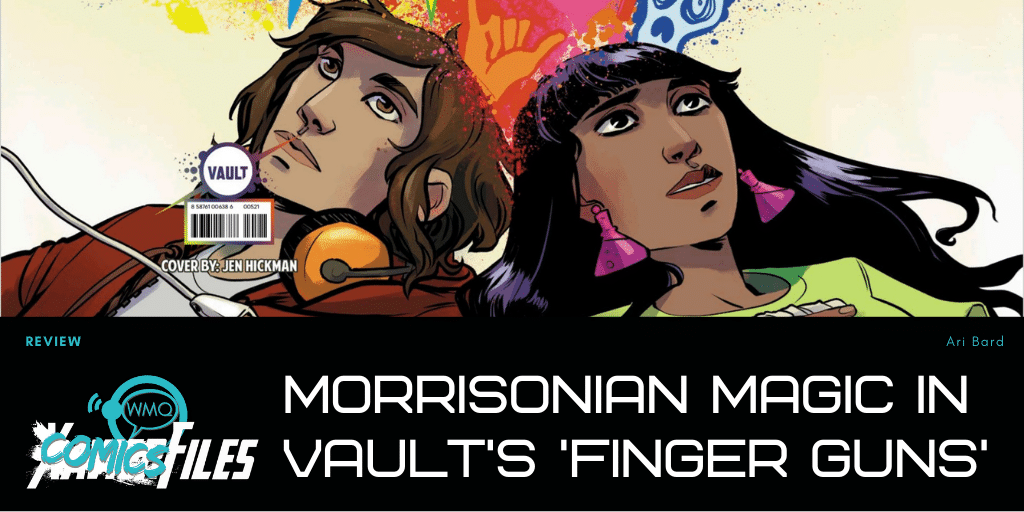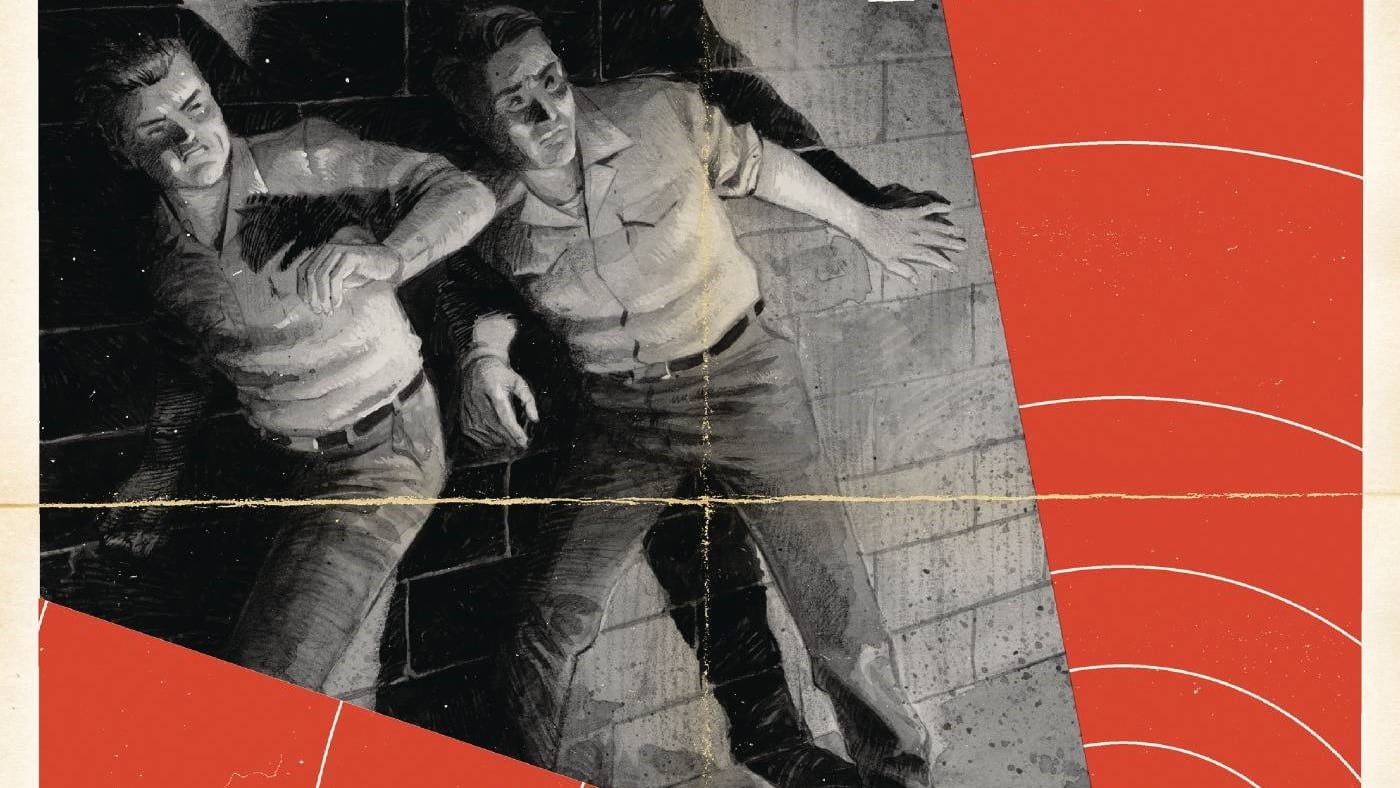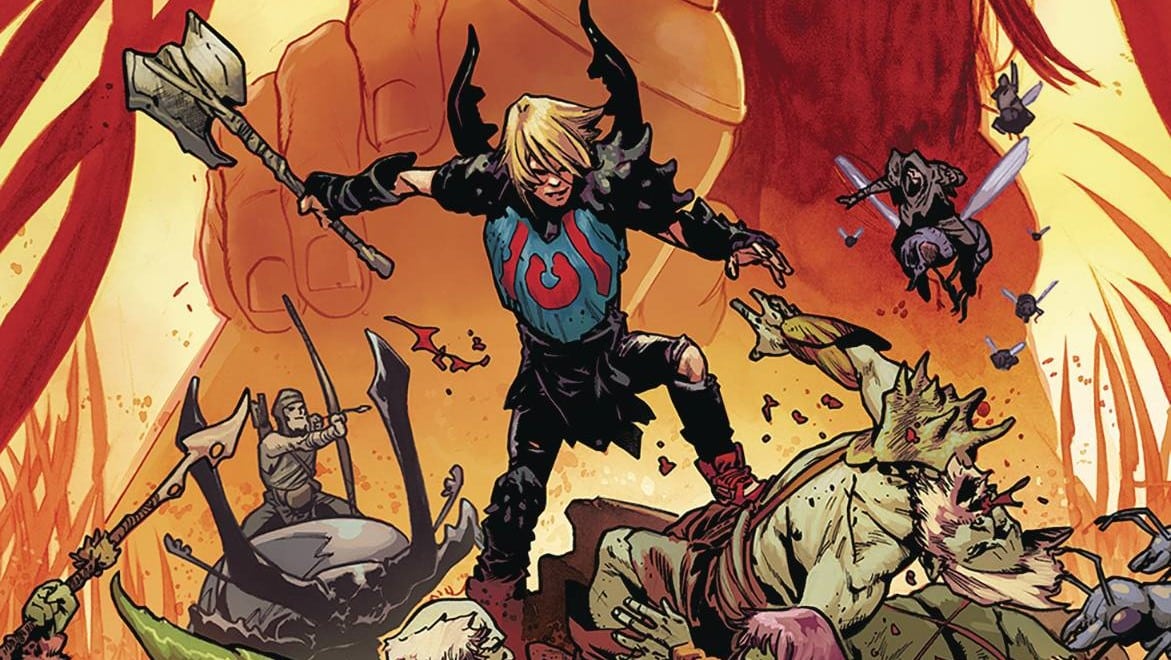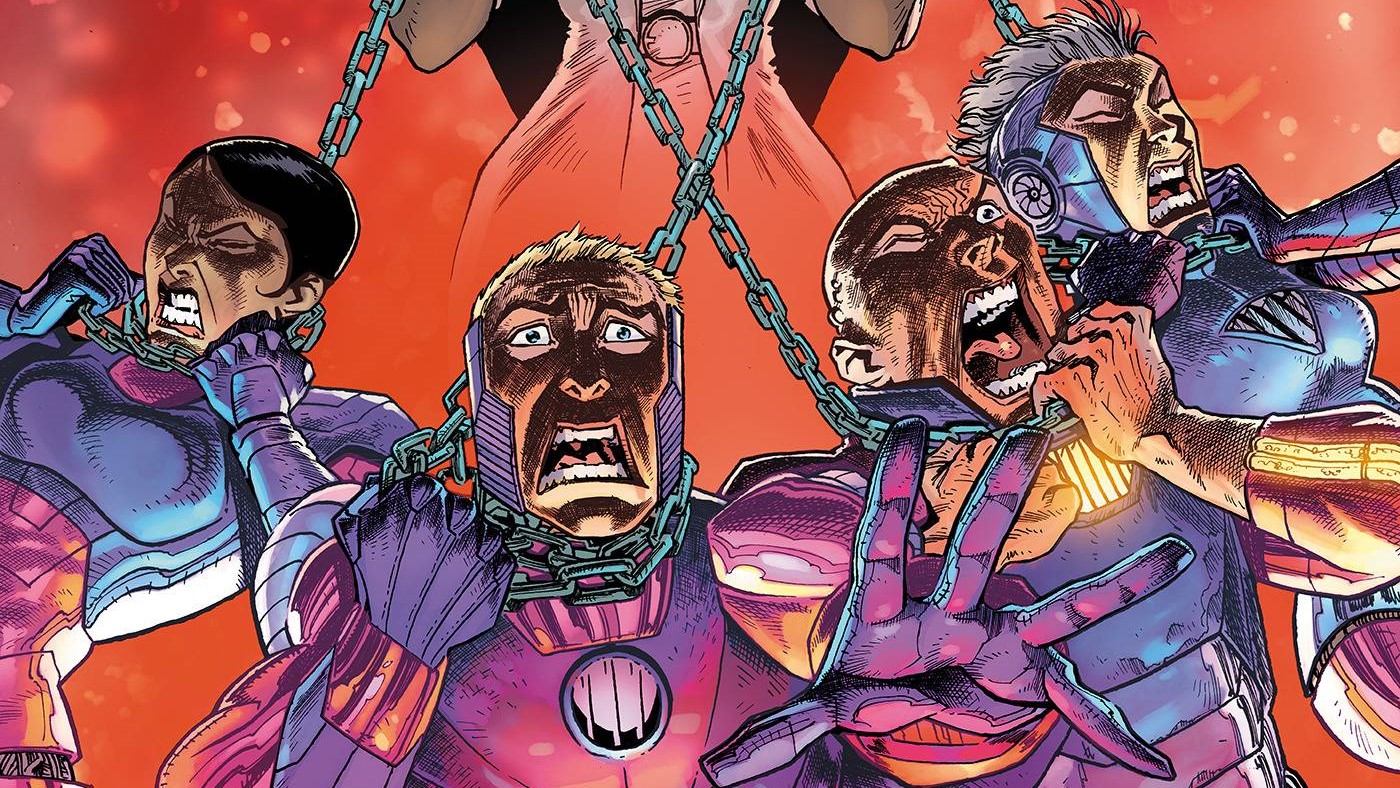
I don’t remember ever feeling as excited about a just-announced comic book as I did when I read the solicit for the first issue of Justin Richards and Val Halvorson’s Finger Guns. I am someone who has only experienced significant parts of the emotional spectrum through art. Try as I might to put myself in situations in order to learn what nostalgia, elation, grief or deep sadness really feel like, I’ve never been able to capture what I see from those around me or within the media I consume.
As soon as I became aware of this, I grew immensely fascinated with reading and learning more about emotions through the worlds and characters created by people who could feel more than I felt I could. I made it my mission to always know and articulate what I was feeling at all times, so that I would know instantly when I was feeling something new.
This has naturally led me to any comic that intimately deals with any sort of unnatural alterations of a person’s emotions or empathy-based abilities. Unfortunately, a lot of stories centered on such elements leave me disappointed, as what they are attempting to portray comes across as dissonant and hollow. Comics can express emotions through words and images simultaneously, and that can manifest the growth and evolution of emotion via a literal image.
Yet when it comes to characters like Empath or Raven, I am left feeling empty. Time and time again, it seemed that when characters stare empathy and emotion directly in the eye is when they fall short, so when Finger Guns was announced, I thought this would finally be my nuanced look at emotion … but that wasn’t what I got. In fact, I’d argue it was never what Finger Guns was trying to be.
Instead, Finger Guns is an in-depth look at the relationships between action, emotion and consequences, and while it may not be what I was looking for, it is just as necessary.

The easiest way to explain how Finger Guns addresses those relationships is through the lens of magic as seen through the eyes of Grant Morrison. Now, Morrison believes in many things surrounding chaos magic and the occult, and while we could debate endlessly about the usefulness of forming your beliefs and desires into sigils, the validity of art as hypersigils put into the universe to change the state of reality, or the truth behind us all existing as cells in a supercellular organism, instead I am going to pull the useful tools from Morrison’s work, or in this case the beliefs, and move on.
The truths behind Morrison’s perceptions of magic can be summarized in two basic tenets that are demonstrated in Finger Guns better than in any other comic. That said, Morrison’s perceptions of magic ultimately break down when they approach the idea of the self and the personality.
Tenet #1: We manifest what we put out into the world
It may have been foolish to expect nuance when finger guns are, in many ways, the bluntest of instruments, but that works in the book’s favor. The emotions Sadie and Wes have at their fingertips are some of the most primitive. Beams that cause mania, rage and calm have effects that are more like drugs than powers, but by simplifying the emotions Sadie and Wes can control, it’s easier to make the connection from emotion to action to emotion to consequence.
When Wes discovers his “Rage Ray,” he is angry at the world for abandoning him. He doesn’t have a lot of friends in school, and his dad hasn’t been there for him since his mom died. He is bored and frustrated and wants to make other people feel that way, too. The first thing he does when he discovers he has the power to make people upset is use it on everyone he can. Doesn’t that reflect what you know about human nature? When we’re angry at the world, we just want to watch it burn, and that is what Wes does. Simply replace the red beam coming out of Wes’ fingers with actions like bumping into someone, letting an elevator door close when someone is trying to catch it, posting something negative online, yelling at someone for making a small mistake, etc. When we’re mad at the world, we do all sorts of small, inconsiderate things just because we can, which causes others to feel angry, which has more consequences. What is more magical than that?
When Sadie’s introduced, she’s as cool as a cucumber, and the calming ray she’s familiar with echoes that. She walks around with an unparalleled aura of confidence and doesn’t let something like Wes bumping into her drastically affect her mood. She’s able to easily calm down strangers that Wes makes angry simply by projecting that energy. It’s akin to little things that brighten up your day when you’re in a bad mood, like someone saving you a snack at the office, someone holding the door for you, someone remaining level-headed during an argument or decision-making process, etc. A person with a calm demeanor is also able to calm down those around them, and that’s exactly what is shown in the pages of Finger Guns.

As the situations get more complex, the idea that the finger guns are just the behavior we project to the world still fits. When Sadie tries to calm down her abusive father, it seems to have a negligible effect. Why is that? It could be because Sadie is not feeling calm when she’s using it, so she has less calm energy to radiate. It’d be difficult to calm someone down or do something nice for someone when you are feeling angry yourself, wouldn’t it? It could also be because Sadie’s father has clear and intentional actions in mind. No matter how calming someone’s presence may be, they likely aren’t going to change the mind of someone with clear hostile intent, and will likely only lessen the blow, and that’s exactly what we see here.
Finger Guns uses Sadie and Wes’ powers to portray magic, the idea that emotions and actions can alter our state of consciousness, but it never goes beyond the threshold of what we might see in real life. This continues when Wes and Sadie learn to use the “mania ray.” I use mania here because I think it fits more with the notion that these powers act more like drugs when it comes to affecting emotions than being a ray of concentrated emotion itself, and the effects of the ray go beyond just feeling courageous or emboldened. People hit with the “mania ray” exhibit overenthusiasm and the immediate desire for action. More than anything else, they want to do something, likely related to what it was they were already thinking about, whether it be dancing or taking a stand against an abuser. In real life, we see this all the time when people encourage or hype up others. How many times have you seen people shy away from a risk until someone gives them that extra push, for better or worse? Just like in real life, this ray has positive effects, like creating a great afternoon for Wes and Sadie, and negative ones, like when Sadie’s mom puts her own life in danger.
In the final issue, we’re exposed to the fear aura. This one appears as an uncontrollable black glow emanating from Sadie’s hand that appears to spread nightmares and fear. We see how easily fear can spread every day just through the internet and conspiracy theories. People eat up and absorb fear unlike any other emotion, and that’s probably part of why Sadie has trouble controlling it. Whether we acknowledge or are conscious of how much emotion we put out into the world, it has an effect on the consciousness of others. It can slightly affect behavior, influence decision-making, affect mood and impact global events.
Social media and technology companies know this and take advantage of it through social hacking and engineering. It’s psychology and neuroscience, but it’s also magic. When we are faced head on with what we fear, we don’t have any control over it either, and it can easily spread out of control, but collective fears require a collective solution, and that leads to…
Tenet #2: Collectivism Strengthens Magic
Morrison gets a bit preachy and centrist here, but there is a point to be made when he talks about how much more we as humans can accomplish when we look beyond ourselves. This comes through in Finger Guns, not through the emotions Wes and Sadie are able to affect with their powers, but through the ones characters are able to affect without powers.

If you look at the most important emotional moments in every issue, they’re often where powers aren’t involved, but where characters are acting selflessly. Sadie and Wes’ friendship grows when they’re being good friends and listening to each other. It flourishes during scenes like the conversation on the playground, playing video games or just talking. Even when their friendship hits a rough patch at the aquarium, it’s much more impactful than anything caused by a ray of emotion.
Richards and Halvorson touch your heart through conversations about music, moms and being a kid, and this transcends Sadie and Wes. Sadie’s mom and Wes’ dad have extremely powerful and vulnerable moments with their kids at the dinner table or on the front porch. When Wes and his dad finally open up about Wes’ mom, that doesn’t magically fix the relationship between them in the long term, but for that moment in the last issue, everything feels OK. It’s in these moments where healing occurs and bonds are formed.
The most underrated character who exemplifies this idea, however, is the guidance counselor, Mr. County. The man is far from perfect. He is very out of touch with those he oversees, and it’s probably very difficult for him to understand the lives of those he oversees. He is often awkward and sometimes puts responsibilities or tasks over personal well-being in conversation, but you could never say Mr. County doesn’t care. He always does his best for Sadie and tries to look out for her and ask the right questions. When he suspects something might be seriously wrong, he turns to Wes, Sadie’s friend. He is observant but respectful, as well as understanding. He saves Chester for Wes, and we see that Wes used to see Mr. County regularly. He knows, on some level, how to build relationships because he always puts the students he is helping first, and that is how the magic forms. He is able to affect change by caring, and there’s as much magic that stems from that as anything else.
But no matter how much people may want to care about others, we simply cannot function if we’re not able to understand or take care of ourselves, and that is the compelling imagery presented at the end of Finger Guns #5.
Morrison has often spoken about abandoning the personality and viewing ourselves as if we were software that could install any update to learn anything, and that’s where things sort of break down. If we lose track of all sense of self in favor of the collective, isn’t that as presbyopic as extreme individualism is myopic? If we lose awareness of our own thoughts, feelings, abilities and shortcomings, how can we best change and adapt for the sake of others?

Personal journeys in a time of doubt are extremely important. When everything feels out of control, it’s important to take a step back and do what’s necessary before rejoining the collective. There’s an inherent lack of control throughout all of Finger Guns that’s important to touch on. We see that sometimes, the rays only come out of one hand, sometimes they don’t work at all, the effect is largely dependent on the person hit by the ray, etc. There are many mysteries to these powers, just like the many mysteries behind emotions themselves.
Beyond that, the rays are always associated with wavy, spiral imagery. Many of the layouts surrounding when Wes and Sadie use their finger guns come in the shape of the spiral, as though these emotional abilities can cause things to spiral out of control. When Sadie sees the aura of fear coming out of her hand, it’s the ultimate manifestation of fear, doubt and uncertainty. We see things begin to spiral out of control one final time as the panels appear to spiral out of the page. Sadie begins to let those emotions consume her as she runs away, but after talking to Wes at the bus stop, it doesn’t seem that way anymore. It seems like she’s realized her own uncertainty and needs to confront it on her own, away from those she cares about.
Some may read that finale and think about the dangers and unrealistic ideal of a kid simply running away. Others may think it’s a cowardly resolution or no resolution at all. How can Sadie be left feeling that way? Well, there are thousands upon thousands of people feeling everything Sadie is feeling every day right now. There’s so much fear and uncertainty and doubt in the world that many of us shoulder alone for years without any sort of neatly packaged resolution. I appreciate that ending because of Wes’ letter. It gives me a lot of hope as I see the effect it has on Sadie in one of the final panels. It makes me think of all the Wesses in the world who support me and all of the people I can be a Wes to.
Because the reality is, we all have shit we’re going through. It’s just that some of us are Wes and have learned to manage, heal and move forward, and some of us are Sadie, navigating a sea of fear and self-doubt. All we can do is remember our own finger guns, and put a little magic into the world to affect change for the better in ourselves and others any way we can.

Ari Bard is a huge comic fan studying Mechanical Engineering so he can finally figure out how the Batmobile works.






